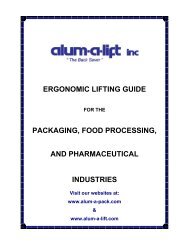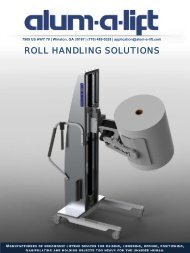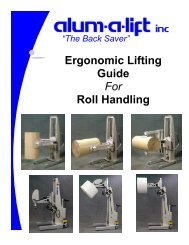Lifting, Lowering, Moving, Positioning, And - Alum-A-Lift
Lifting, Lowering, Moving, Positioning, And - Alum-A-Lift
Lifting, Lowering, Moving, Positioning, And - Alum-A-Lift
You also want an ePaper? Increase the reach of your titles
YUMPU automatically turns print PDFs into web optimized ePapers that Google loves.
GENERAL LIFT INFORMATION<br />
Static System<br />
The static (framework) provides structure to which the electrical and drive systems are<br />
mounted. This system is comprised of:<br />
• Welded Frame • Leg Assembly<br />
• Base Assembly<br />
• Top Channel Assembly<br />
• Ergonomic Handles<br />
• Struts<br />
The lift is comprised of numerous subsystems. The most basic framework involves the<br />
mounting of a frame assembly to a base assembly. Mounted to the base assembly are<br />
two leg assemblies. These subassemblies make up a very stable and mechanically<br />
strong system.<br />
Dynamic System<br />
The dynamic system (drive) provides motion and power in the form of upward and<br />
downward movements of the carriage. The carriage is designed to accommodate a variety<br />
of end-effectors. The dynamic system includes:<br />
• Gear Motor • Brake<br />
• Alignment Couple • Ball Screw<br />
• Ball Nut Assembly<br />
• Pillow Block Bearings<br />
• Carriage Assembly<br />
The lift’s carriage is driven up and down by a DC gear motor driven ball screw that runs<br />
vertically along the inside of the structure.<br />
Ball Screw Design Advantages 1<br />
“A ball bearing screw is well described by its name; it’s a screw that runs on ball bearings.<br />
The balls provide the only physical contact between screw and nut, replacing the sliding<br />
friction of a conventional screw with a free and smooth rolling motion. In a ball bearing<br />
screw the return tubes carry the ball bearings from the end of their travel, over the screw and<br />
back to the start of the circuit to form a continuously recirculating path. A ball bearing screw<br />
is extremely energy efficient, about 90% – three times more efficient than conventional<br />
screws. The primary function of a ball bearing screw is to convert rotary motion to linear<br />
motion – or torque to thrust.” In the case of the lift, this linear motion is accomplished by<br />
rotating the screw and having the nut travel up or down. A load locking spring is featured on<br />
the <strong>Alum</strong>-A-LIft. This spring is a coil turned into the inactive portion to the nut that conforms<br />
to the ball tract. During normal operation, the spring is inactive and not in contact with the<br />
screw. In the event the ball bearings are lost from the nut, the load locking spring will not<br />
allow the load carrying nut to free-fall down the screw.<br />
1. (http://www.uslinear.com/config/BSHelp/Balscrew/Design_Advantages_of_Ball_Bearing_Screws.htm)





